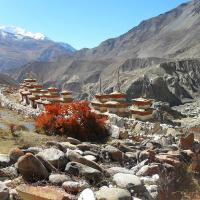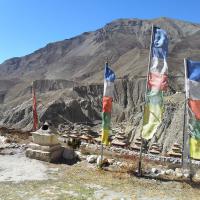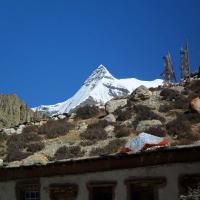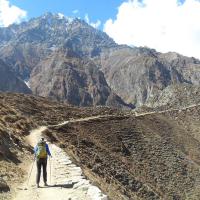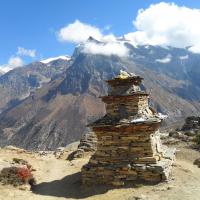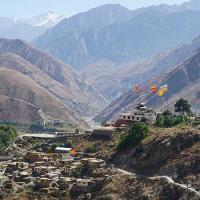

Email Us
contact@destinationhimalayatreks.com
Viber/Whats App 
+977-98510 16814 (Min Gurung)+977-98511 46814 (Tara Rana)
Nar Phu Valley Trek with Annapurna Circuit
$1275 per Pax
Overview
Nar Phu Trek in Nepal is the hidden gem nestled in the Annapurna region. It is one of the rare and privileged treks in the restricted region of Nar Phu valley. The Nar Phu trek was opened in 2003 and still remains relatively little trek area lying on the most remote side of Manang, access to this jaw dropping place is provided only with a purchased permit. During the winter season, these areas are covered with snow and sloppy trials hence, the trek is only possible during favorable trek season.
The two valleys of Nar and Phu are the main highlights which is situated just off the Annapurna circuit route the trial to Nar Phu valley, it offers a unique trekking experience with breathtaking landscapes, Tibetan culture, remote villages, forests, narrow canyons, the waterfalls, majestic mountains and suspension bridges, the two famous passes Kangla Pass and Thorong La Pass and none other than the Himalayan region.
The trip begins with the sightseeing around the world heritage sites and hindu temples in Kathmandu valley. The trek starts from Dharapani where the trials are rough, rugged and winding yet the sceneries captivate the trekkers throughout the journey.
The route to Nar Phu valley goes through Manang and continues over the Thorong La Pass at the Hindu pilgrimage town of Muktinath temple which is believed that a person gets salvation upon visiting the temple. While passing through the Nar phu valley, it is possible to take in culture of people living in there with great enthusiasm.
The final scenic flight to Pokhara allows jaw dropping view of the great Himalayan ranges. The last day of Pokhara can be utilized by sightseeing beautiful lakes, temples, Buddhist Gumpas, Boating or just roaming around the city as you prefer.
Since the normal Annapurna circuit has been easily accessed by convenient roads, the Nar Phu trek can be a great escapism filled with adventurous trek, delightful culture and local foods, the Nar Phu trek can be a great replaceable trial to enjoy the trek along the countryside of Nepal.
- Real Himalayan wilderness, exotic and sparsely populated valleys of Nar and Phu
- Mysterious valleys with alpine forests, rugged landscapes, deep and Narrow River gorges, diverse flora and fauna
- Fascinating medieval Tibetan culture and customs, unique and colorful prayer stones, and monasteries
- Venture into a remote and ancient village in its original form
- Tibetan influenced architecture in the Gompas and monasteries
- Witness surreal large panorama peaks of Annapurna II, Himlung Himal, Gangapurna, and Tilicho Peak right in front of Kang La Pass.
- Hike to Muktinath, Camp in Buddhist monasteries
Short Itinerary
Day 01: Arrival Kathmandu and transfer to hotel
Day 02: Permit procedure for Nar Phu, Sightseeing around Kathmandu
Day 03: Take a drive Bus to Beshisahar by take a local jeep to Dharapani
Day 04: Dharapani to Koto (2600m)
Day 05: Koto to Meta (3560m)
Day 06: Meta to Kyang, (3820m), Overnight on tented camp
Day 07: Kyang to Phu (4010m)
Day 08: Exploration day
Day 09: Phu to Nar Phedi
Day 10: Nar Phedi to Nar (4110m)
Day 11: Nar to Kang La Phedi (4530m)-Pass Kang La (5306)m and to Nawal (approx 10 hours)
Day 12: Nawal to Manang (3540m)
Day 13: Rest day
Day 14: Manang to Yak Kharka (4050m)
Day 15: Yak Kharka to Thorong High Camp (4925m)
Day 16: High Camp to Jomsom (3760m) via Thorong La Pass (5416m)
Day 17: Take a flight to Pokhara, overnight hotel
Day 18: Pokhara to Kathmandu by tourist bus or flight, overnight hotel
Includes
- All land transportation as required for trip and airport pick up-drop.
- Hotel in Kathmandu and Pokhara as indicated program
- Flight to Pokhara from Jomsom
- Accommodation and food during the trek.
- Nar Phu Valley entry permit,trekking permit and national park permit.
- Related language speaking guide and necessary porters.
- Emergency evacuation service if in case...
- farewell dinner after trip.
Excludes
- Food in Kathmandu and Pokhara
- Bar bills and beverage
- Personal trekking gears
- Rescue charge in case needed
Detail Itinerary
-
Day 01: Arrival in Kathmandu (1350m.), transfer to Hotel
On your arrival at the Tribhuvan International airport, the representative of Destination Himalaya treks gives you warm welcome in the adventurous Himalayan country Nepal. After welcoming at airport you will be transferred to the hotel in Thamel. Hotel welcomes you with a glass of fresh juice and do the formalities for check in. You will have a short meeting with a agency's person for financial settlement and introduce with tour guide. The guide will explain about itinerary what things you are going to do in Kathmandu, overnight hotel.
-
Day 02: Guided sightseeing tours around Kathmandu Valley and Bhaktapur Darbar Square, overnight Hotel
You just get ready at hotel after taking breakfast on the time guide mentioned yesterday in meeting. You will be taken to Baudhnath Stupa which is the biggest Stupa in the world, Hindus Temple Pashupatinath, The Temple is very famous for Hindus all over the world. Now you drive to Bhaktapur Darbar Square which takes about an hour if the road is clear, there is no traffic usually in the morning. Bhaktapur Darbar Square is one of the most beautiful mythological sights in Nepal. the palace with 55 windows, Nyatpola, Handicrafts, Thanka Painting and pottery squares are highlights of the tour. It's the big sight so it will take more time to explore the square, There are so many nice restaurants with rooftop terrace in Darbar Square area for lunch and then you will be taken to Patan Darbar Square, overnight the same hotel
-
Day 03: Take a drive to Besisahar by bus and change a local jeep to Dharapani
Our journey to the once-forbidden valley begins. We depart in the morning after breakfast in a scenic drive to the hilly town of Besisahar with public bus, we can serve you private transportation on request. On our drive along the Prithvi Highway, we shall get opportunities to observe the lifestyle of rural areas. From Besisahar we shall take on a local jeep to our destination Dharapani, one of the larger villages in the Manang valley. We shall also observe the rice and potato fields, alpine forests, waterfalls and cliffs, and some suspension bridges along the way to Dharapani, overnight lodge at Dharapani.
-
Day 04: Dharapani to Koto (2600m)
We start our trek in the morning through the pine and fir forests and hilly landscapes. Bit of a difficult trek for today. For our amusement shall be the whitewashed monastery, the awesome Himalayas of Annapurna II, Manasalu, Lamjung Himal, and Himalchuli guarding the region since time unknown, unique lifestyles in the villages of Timang, Danaque, and Latamarang. The uphill climb and descent shall be of around 5-6 hours for the day. After the effortful journey, we shall arrive at Koto. Overnight in Koto.
-
Day 05: Koto to Meta (3560m)
The alpine vegetation, pine, and rhododendron forests shall accompany us today as well. We shall traverse along the Naar river on our way to Meta. From Koto we leave the trails of classic Annapurna Circuit. Through several suspension and wooden bridges, waterfalls, forests and steep ascends we reach the Meta village, past the village of Dharmashala, through the trail carved into the narrow and steep-sided walls of the Naar river. The slowly changing landscape and view of Annapurna and Lamjung Himal shall keep us energized on the trek. Overnight in Meta.
-
Day 06: Meta to Kyang, (3820m), overnight lodge
Today we set ourselves to the Phu valley of the region in a relatively short trekking day. Along the Phu River flowing down the Phu valley, our trek shall continue past the big chorten near the Naar Phedi, through the forests up the Mahendra Pul, crossing the Mruju Khola as we approach the high plateau of Kyang for overnight staying. Kyang has the remains of the Khampa settlements where once the Khampa refugees from Tibet settled, overnight lodge in Kang.
-
Day 07: Kyang to Phu (4010m)
We ascend further into the Phu valley today and aim to reach the Phu village. The rocky trail ahead of the Kyang makes us put more strength yet not pace up much. The magical village of Phu is reached as we experience the Tibetan Buddhist culture in the prayer flags, chorten, and Mani walls all along the trekking trail. Phu valley welcomes us as we make the final ascent to the Phu gate, the entrance to this medieval village. Overnight in Phu.
-
Day 08: Acclimatization day
Today we shall witness the magic of Phu valley unfolding before us as we explore this ancient village. This also allows for the proper acclimatization for us before we do further trekking. Beautiful and barren landscape, Tibetan influenced architecture in the Gompas and monasteries, natural diversity and the lifestyle of the locals shall keep us engaged all day long. This hidden valley shall display the religious practices of the local Lama, Gurung, and Ghale community, the Tashi Lakhang Monastery (supposedly the last monastery built by Karmapa Rinpoche) along with the marvelous view of the Himlung peak and its sibling peaks in the region. Overnight in Phu.
-
Day 09: Phu to Nar Phedi
Retracing our footsteps we exit out of the Phu village and move down to the small settlement of the Nar Phedi. We move past the Mahendra Pul, named after the small bridge built by the shah king, King Mahendra. The trail branches off at the Nar Phedi. Overnight in Nar Phedi.
-
Day 10: Nar Phedi to Nar (4110m)
Another relatively short day on our trekking schedule is to take place today. We go through a steep path to Nar with caution. This effort shall be rewarded by nature with the snow capped Kang Garu peak standing tall and proud overlooking the trail. Following the Mani walls, gompas, and a mud walled hut we march ahead to be greeted by the entrance gate of the Nar valley. Slightly bigger than Phu, Nar provides an incredible view of Pisang peak and Kang Garu, the barley cultivation and unique local culture. Overnight in Nar.
-
Day 11: Nar to Kang La Phedi (4530m)-Pass Kang La (5306)m and to Nawal (approx 10 hours)
Today, a long beautiful and adventurous day waits for us. We shall be welcomed by the second gate of the Nar valley as we trail across the west highlands of Pisang peak standing to our left. Upon reaching the Kang La Phedi, we can see local lodge - tea shop if it's open, we could continue walk in here instead of overnight in Nar last night. Your guide will handle these things during the trek. A real highlight of the trip, we climb over the Kang La pass (5306m), the highest point of our trek. Stunning views of Annapurna, Gangapurna, Tilicho Peak, and beyond are seen from this pass. A straight forward but steep descent is encountered down the pass as a part of the path consists of moraine and some part has grassy terrain as we move towards Nawal. Caution is to be maintained as the descent can be strenuous to the knees, overnight in Nawal.
-
Day 12: Nawal to Manang (3540m)
From Nawal, it's time we trek to Manang. With the relatively easy and short trail down the bank of the Marshyangdi River, the pace of the trek can be done more gradually by the trekkers. The view of Annapurna and Tilicho peak all day, the uniquely beautiful villages with Gurung settlement, and beautiful pine forest shall add beauty to the trail. Manang has some beautiful monasteries and more comfortable tea-houses as compared to the stay on previous days, in more remote regions. Overnight in Manang.
-
Day 13: Acclimatization in Manang
This is the second scheduled rest day of the trekking adventure for acclimatization and also to give some break from the continuously strenuous trekking for the past couple of days. We shall explore this rain shadow area with rich natural flora and fauna that gives the feel of being in heaven to many trekkers visiting this area. Overnight in Manang.
-
Day 14: Manang to Yak Kharka (4050m)
We ascend the beautiful Manang towards the village of Yak Kharka, the name after the summer pastures for yak. Crossing the rivulet we continue to traverse away from the Marshyangdi valley northward where we shall pass the village of Tengi, the oldest village in Manang. The pastures, juniper trees, and beautiful landscape tea houses are seen along our trek in the Jarsang Khoa valley. The trail has in display the ancient Mani wall in a pleasant meadow, the wooden bridge along the way are new experiences for the trekkers. Overnight in Yak Kharka.
-
Day 15: Yak Kharka to Thorong High Camp (4925m)
Today’s trek has some ascend and descend in higher altitudes. After a couple of hours’ climb, we descend to cross a stream and again have an uphill climb towards the Thorong High Camp. We pass through Thorong Phedi, a small village that has been busy serving the trekkers and climbers, many of whom use this as the base camp before their ascend to the Thorong La pass. In between, we have encountered some steep ascend as well. Overnight at Thorong High Camp.
-
Day 16: High Camp to Jomsom via Thorong La Pass (5416m)
We have some seriously beautiful but demanding days where we cross the difficult yet exciting Thorong La pass. An early morning start to this section of the trek shall help us complete our trek more comfortably. The strenuous climb and ascent to the pass through the bumpy and rocky path is worth the breathtaking vista we witness from the summit. We then descend on the other side of the pass to Muktinath, a pilgrimage that hosts both the Hindu temple and a monastery nearby. Muktinath is the place believed to give salvation to the pilgrims who visit this holy place, for the picturesque Jomsom. After lunch at Muktinath we walk through the villages of Jharkot and Khingar with Tibetan influence and mostly along the banks of the Kali Gandaki river, we reach the arid yet beautiful Jomsom.
-
Day 17: Take a flight to Pokhara
The demanding yet worthwhile adventure trek comes to an end. We take a flight to the scenic city of Pokhara in normal conditions. However, if there is no flight due to bad weather or other reasons we take a local bus to Pokhara that is no less comfortable for you. For the rest of the day, trekkers can have sightseeing around the Lake City of Nepal to Fewa Lake, Davis Falls, Gupteshwor Cave, the Mountaineering Museum, and others. Overnight in Pokhara.
-
Day 18: Pokhara to Kathmandu by tourist bus or flight
Marking the end of this memorable trip we shall move back to Kathmandu by tourist bus or flight as per the weather condition in Pokhara. Trekkers may trade mails and organize their photographs before packing up bags for the final departure to their respective destinations. End of a fantastic journey!
-
Travel Info
Accommodation and Duration
Accommodations in the Nar Phu Valley Treks are mostly guesthouses. The guesthouses are comfortable with basic facilities. The trek duration is of 20 days. Thus, most nights are spent in the guesthouses. A stay at the tent once in the Kang La Phedi before ascending Kang La Pass (5,306m). The extra charge for the use of facilities like hot water buckets, laundry, charging, internet, and electricity in the guesthouses.
Meals
Breakfast, Lunch, and Dinner are provided during the trekking from the guesthouses. The meals are basic and suitable for the health of the trekkers. The main dish is Nepali Dal Bhat which provides enough energy throughout 7/8 hours of the trek. The variety of meals is hard to find but meals prepared from home-grown crops are a treat during this trek.
Drinking water
Drinking water is easily available at the guesthouses. You can buy a mineral water bottle but you should do proper disposal of plastic bottles. You can also fill boiled water at guesthouses paying extra charges. Carry a water bottle and water purification medicine with you. During trekking, drink direct freshwater from the flowing stream using water purification treatment.
Communication
The internet facility is easily available in the vicinity of the Annapurna region. The internet is stable from Besisahar to Manang valley. A little instability or no availability at high altitudes. By paying extra charges at guesthouses, internet facility, electricity for charging can be used. The phone signal is also good but may not work at high altitudes. Using a local sim card, an internet facility can also be used.
Starting and Ending points
The starting point of the Nar Phu Valley Trek is from Besisahar and ends in Jomsom. From Jomsom, take a flight to Pokhara and return Kathmandu.
Permits
The required permits are Nar Phu restricted area permit (RAP) and Annapurna Conservation Area Permit (ACAP). Their costs are:
Nar-Phu RAP Fee
USD 100/week per person + USD 15/person per day (beyond a week) [Sep-Nov]
USD 75/week per person + USD 10/person per day (beyond a week) [Dec-Aug]
Annapurna Conservation Area Permit (ACAP)
Foreigners- NPR 3000/person
SAARC- NPR 1000/person
Travel Insurance
Travel Insurance is very helpful and a safety net for travelers/trekkers. Travel Insurance must cover all medical emergencies, flight cancelations, emergency evacuations, loss of luggage, and altitudes over 3000 m.
Nar Phu Trek Difficulty
Nar Phu Valley Trek’s difficulty is moderately challenging. The trek includes a trail having many steep ascends, descends, rough trails, and icy and slippery during winter and rainy seasons. Trekkers need to traverse two passes Kang La (5,306m) and Thorong La Pass (5,416m).The trekker with average physical fitness and good health condition can complete the trek. Proper preparation and guidance before starting the trek are fruitful.
Best time to trek Nar Phu
Spring and Autumn seasons are the best time to trek Nar Phu Valley. The weather is clear and sunny during these seasons. The trail is also comfortable to walk. Rainy and Winter season treks are riskier due to muddy, icy, and slippery trails. It is only for experienced trekkers with full preparation before the trek.
Luggage limitation for Porter
One porter carries the luggage of two trekkers. The luggage limitation per person is a maximum of 15 kg.
Acclimatization and Altitude Sickness
Acclimatization day is necessary during trekking. Phu Valley and Manang valley are our acclimatization rest days. It helps prevent altitude sickness and adapt to the environment.
Symptoms of Altitude Sickness
Primary: Headache, nausea, gasping, appetite & sleep loss, dizziness, fatigue, vomiting
Extreme: primary symptoms and hallucinations & unconsciousness
Preventive Guidelines
- Immediately inform the guide
- Warm-up, and body stretch before the trekking journey
- Drink water and Hydrate yourself at regular intervals
- Frequent urination throughout the journey
- Ascend slowly and gradually
- Take plenty of rest and sleep
- Avoid salty foods, alcohol, and smoking
- Descend immediately when it’s difficult/uneasy
- Take medicine consulting a guide
Shoes: Pair of hiking boots, Rubber sandals
Clothes: Windcheater jacket, Thermals, Down Jacket, Fleece, Long sleeve shirts, Gloves, Towels, Inner garments, Trekking pants, Trousers, Shorts, Socks
Accessories: Sunglasses, Hats/Caps, Sunscreen, Lip Balm, Water bottles, Pocket Knife, Water Purifying solution
Equipment: Warm Sleeping bags, Map, Trekking poles, Duffel bag
Medicine: First-Aid Kit, Altitude sickness medicines
Rainy season: Waterproof clothes, boots, Raincoat, Anti-leech socks
Winter Season: Woolen clothing items (light)
It is best to bring the clothes and essential equipment from your home from the provided checklist. Also, you can buy or rent equipment and clothes in Kathmandu.

